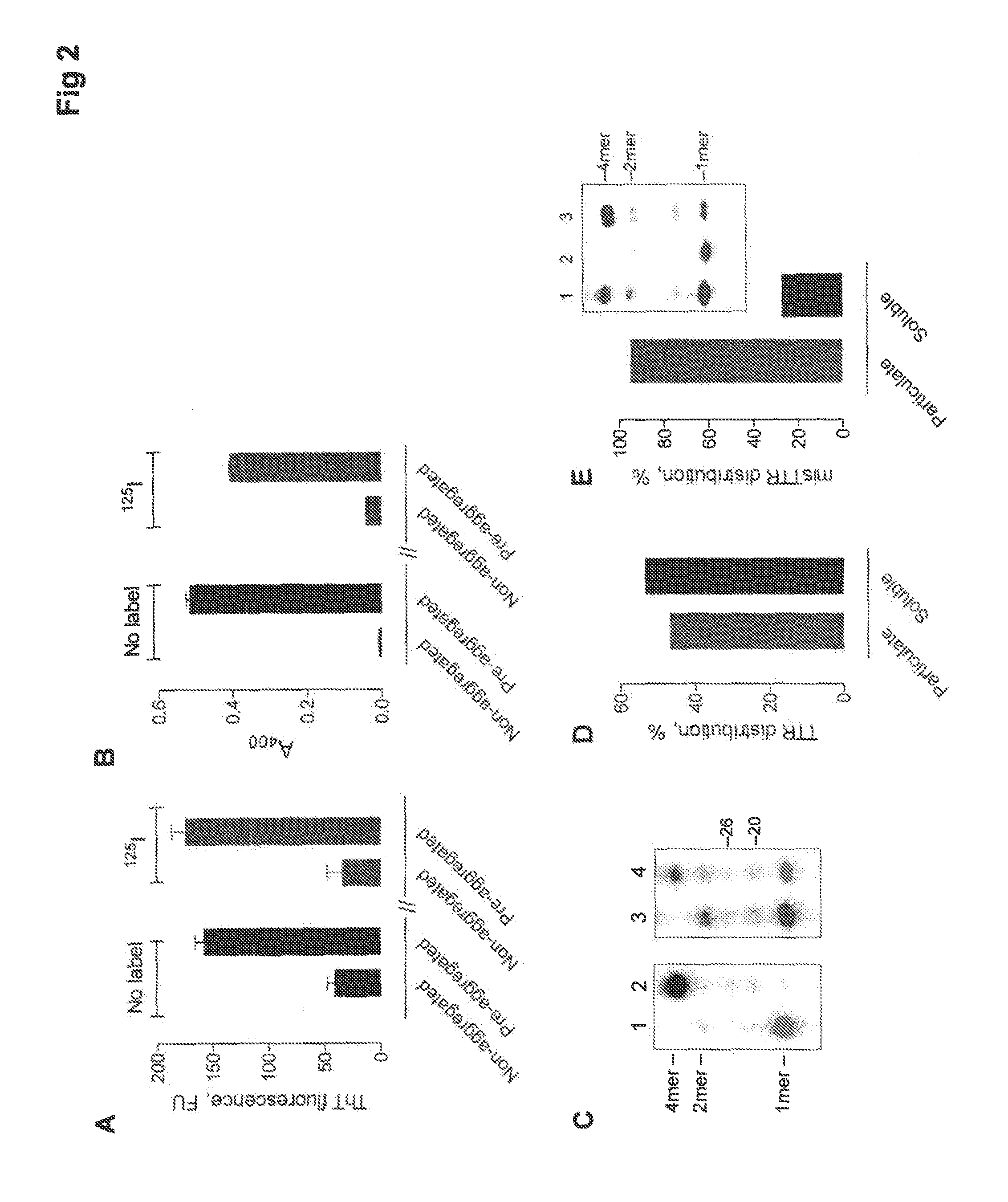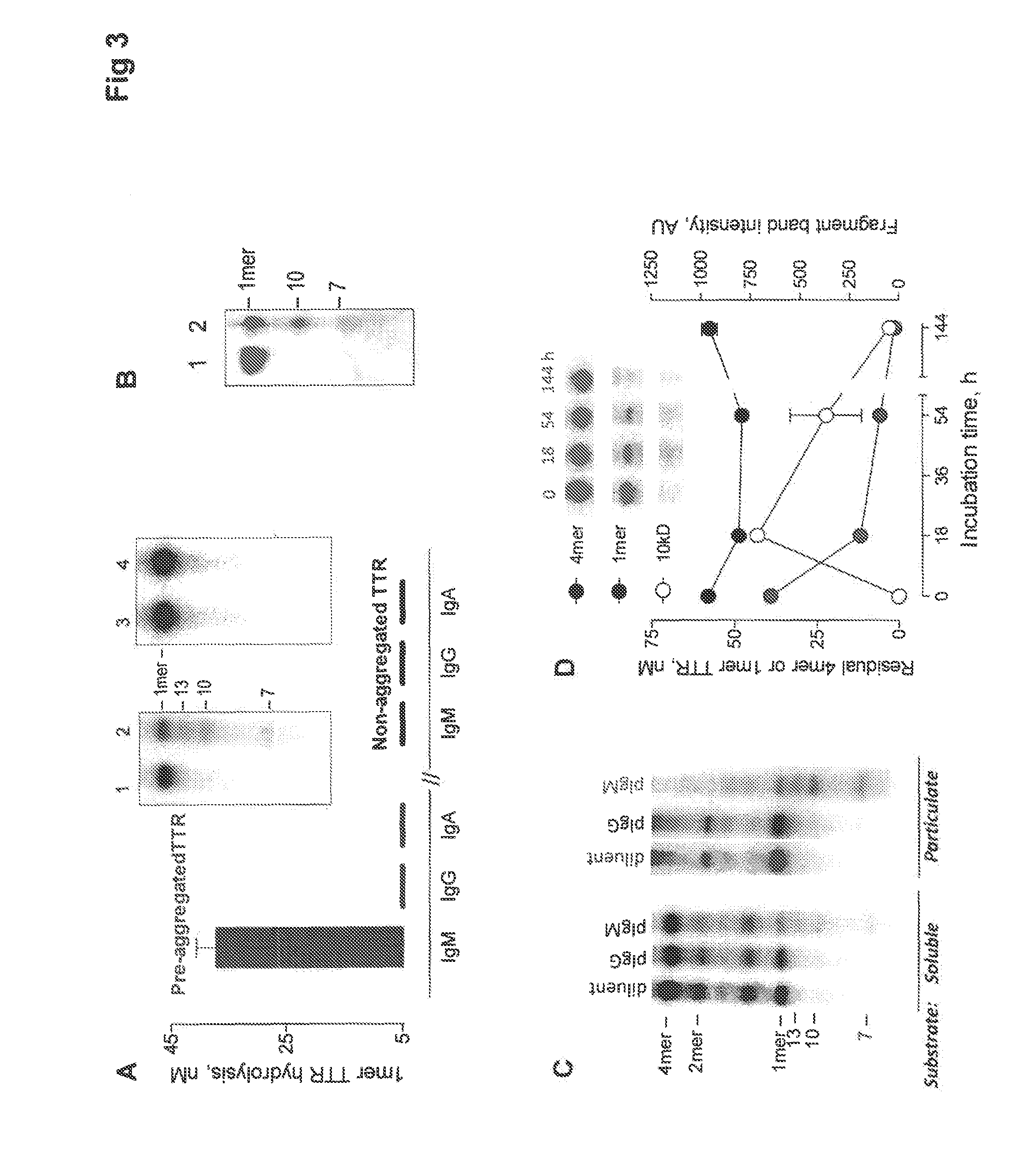Transthyretin amyloid-selective and polyreactive catabodies
a technology of transthyretin and amyloids, applied in the field of immunology, can solve the problems of no known physiological function for age-associated accumulation of misfolded amyloids, no approved drug available, and interference with physiological ttr functions
- Summary
- Abstract
- Description
- Claims
- Application Information
AI Technical Summary
Benefits of technology
Problems solved by technology
Method used
Image
Examples
example 1
Physiological IgM Class Catalytic Antibodies Selective for Transthyretin Amyloid
[0064]Higher organisms possess a structurally diverse innate repertoire of antibody variable (V) domains that was shaped by evolutionary selection pressures imposed by foreign antigens and self-antigens over millions of years. The diversity is supplemented by somatic randomization of the V-domains by acquired immunity processes, which enables selection of V-domains with noncovalent antigen binding activity over a few weeks upon contact with an antigen. Polyreactive catalytic antibodies (catabodies) with a promiscuous peptide bond hydrolytic activity, on the other hand, are produced as an innate property of B cells, requiring no exposure to the antigen [37, 56]. The proteolytic activity was traced to serine protease-like sites in the germline antibody V-regions, suggesting an ancient origin of the catabodies [29, 57-59]. Humans produce catabodies selective for amyloid β peptide (Aβ) [55]. Immune tolerance...
example 2
Isolation of Renewable Catabody Sources WITH misTTR-DIRECTED AND POLYREACTIVE CATALYTIC Activity
[0108]The misTTR-selective catabodies fulfill a homeostatic surveillance function for removing small misTTR amounts formed as the byproduct of the TTR folding pathways. The catabodies can also be applied for removing tissue amyloid deposits. Renewable monoclonal catabody sources prepared from the B cells of healthy humans are described. The catabody properties pertinent to the anti-amyloid defense function are also described.
Renewable Catabody Sources
[0109]Nucleophilic catalysis is an innate, germline V-gene encoded function. For TTR amyloid, the noncovalent specificity-conferring function is also an innate catabody property [5]. The catalytic activity is best expressed by IgMs produced early in B cell ontogeny [37, 137]. The covalent reactivity of electrophilic phosphonate probes with nucleophilic IgM class BCRs was documented [37]. To select specific monoclonal catabodies, electrophilic...
example 3
Adaptive Amplification of Nucleophilic CATABODIES BY misTTR AND ELECTROPHILIC misTTR ANALOGS
[0128]Non-electrophilic immunogens do not generally induce catabodies as B cell differentiation is driven by immunogen binding, and catalytic immunogen hydrolysis is not known to be a selection pressure for B cell growth and development into antibody-secreting cells [40, 152]. In contrast, as the misTTR-directed catalytic activity is an innate property, the E-misTTR and NE-misTTR analogs described in the Examples 1 and 2 induce adaptive strengthening of the innate BCR nucleophilicity coordinated with improved noncovalent binding of misTTR. This is supported by previous studies that electrophilic analogs of gp120 induce the synthesis of specific catabodies to gp120 [39]. Application of the E-misTTR and NE-misTTR immunogens is useful for isolating therapeutic catabodies to misTTR. In addition, these immunogens are useful to develop prophylactic and therapeutic vaccines against amyloidosis, both...
PUM
| Property | Measurement | Unit |
|---|---|---|
| concentrations | aaaaa | aaaaa |
| concentrations | aaaaa | aaaaa |
| retention volume | aaaaa | aaaaa |
Abstract
Description
Claims
Application Information
 Login to View More
Login to View More - R&D
- Intellectual Property
- Life Sciences
- Materials
- Tech Scout
- Unparalleled Data Quality
- Higher Quality Content
- 60% Fewer Hallucinations
Browse by: Latest US Patents, China's latest patents, Technical Efficacy Thesaurus, Application Domain, Technology Topic, Popular Technical Reports.
© 2025 PatSnap. All rights reserved.Legal|Privacy policy|Modern Slavery Act Transparency Statement|Sitemap|About US| Contact US: help@patsnap.com



